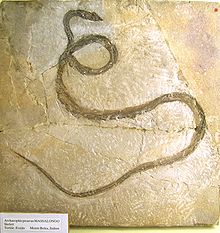| A phylogenetic overview of the extant groups
Note: the tree only indicates relationships, not evolutionary branching times. |
The fossil record of snakes is relatively poor because snake skeletons are typically small and fragile, making fossilization uncommon. Fossils readily identifiable as snakes (though often retaining hind limbs) first appear in the fossil record during the Cretaceous period. The earliest known snake fossils come from sites in Utah and Algeria, represented by the genera Coniophis and Lapparentophis, respectively. These fossil sites have been tentatively dated to the Albian or Cenomanian age of the late Cretaceous, between 112 and 94 Ma ago. However, an even older age has been suggested for one of the Algerian sites, which may be as old as the Aptian, 125-112 Ma ago.
Based on comparative anatomy, there is consensus that snakes descended from lizards.:11 Pythons and boas—primitive groups among modern snakes—have vestigial hind limbs: tiny, clawed digits known as anal spurs, which are used to grasp during mating.:11 The Leptotyphlopidae and Typhlopidae groups also possess remnants of the pelvic girdle, sometimes appearing as horny projections when visible.
Frontal limbs are nonexistent in all known snakes. This is caused by the evolution of Hox genes, controlling limb morphogenesis. The axial skeleton of the snakes’ common ancestor, like most other tetrapods, had regional specializations consisting of cervical (neck), thoracic (chest), lumbar (lower back), sacral (pelvic), and caudal (tail) vertebrae. Early in snake evolution, the Hox gene expression in the axial skeleton responsible for the development of the thorax became dominant. As a result, the vertebrae anterior to the hindlimb buds (when present) all have the same thoracic-like identity (except from the atlas, axis, and 1–3 neck vertebrae). In other words, most of a snake’s skeleton is an extremely extended thorax. Ribs are found exclusively on the thoracic vertebrae. Neck, lumbar and pelvic vertebrae are very reduced in number (only 2–10 lumbar and pelvic vertebrae are present), while only a short tail remains of the caudal vertebrae. However, the tail is still long enough to be of important use in many species, and is modified in some aquatic and tree-dwelling species.
Modern snakes greatly diversified during the Paleocene. This occurred alongside the adaptive radiation of mammals, following the extinction of (non-avian) dinosaurs. The colubrids, one of the more common snake groups, became particularly diverse due to preying on rodents, an especially successful mammal group. There are over 2,900 species of snakes ranging as far northward as the Arctic Circle in Scandinavia and southward through Australia and Tasmania. Snakes can be found on every continent (with the exception of Antarctica), in the sea, and as high as 16,000 feet (4,900 m) in the Himalayan Mountains of Asia.:143 There are numerous islands from which snakes are absent, such as Ireland, Iceland, and New Zealand.:143
Origins
The origin of snakes remains an unresolved issue. There are two main hypotheses competing for acceptance.
- Burrowing Lizard Hypothesis
There is fossil evidence to suggest that snakes may have evolved from burrowing lizards, such as the varanids (or a similar group) during the Cretaceous Period. An early fossil snake, Najash rionegrina, was a two-legged burrowing animal with a sacrum, and was fully terrestrial. One extant analog of these putative ancestors is the earless monitor Lanthanotus of Borneo (though it also is semiaquatic). Subterranean species evolved bodies streamlined for burrowing, and eventually lost their limbs. According to this hypothesis, features such as the transparent, fused eyelids (brille) and loss of external ears evolved to cope with fossorial difficulties, such as scratched corneas and dirt in the ears. Some primitive snakes are known to have possessed hindlimbs, but their pelvic bones lacked a direct connection to the vertebrae. These include fossil species like Haasiophis, Pachyrhachis and Eupodophis, which are slightly older than Najash.

- Aquatic Mosasaur Hypothesis
An alternative hypothesis, based on morphology, suggests the ancestors of snakes were related to mosasaurs—extinct aquatic reptiles from the Cretaceous—which in turn are thought to have derived from varanid lizards. According to this hypothesis, the fused, transparent eyelids of snakes are thought to have evolved to combat marine conditions (corneal water loss through osmosis), and the external ears were lost through disuse in an aquatic environment. This ultimately lead to an animal similar to today's sea snakes. In the Late Cretaceous, snakes recolonized land, and continued to diversify into today's snakes. Fossilized snake remains are known from early Late Cretaceous marine sediments, which is consistent with this hypothesis; particularly so, as they are older than the terrestrial Najash rionegrina. Similar skull structure, reduced or absent limbs, and other anatomical features found in both mosasaurs and snakes lead to a positive cladistical correlation, although some of these features are shared with varanids.
Genetic studies in recent years have indicated snakes are not as closely related to monitor lizards as was once believed—and therefore not to mosasaurs, the proposed ancestor in the aquatic scenario of their evolution. However, more evidence links mosasaurs to snakes than to varanids. Fragmented remains found from the Jurassic and Early Cretaceous indicate deeper fossil records for these groups, which may potentially refute either hypothesis.